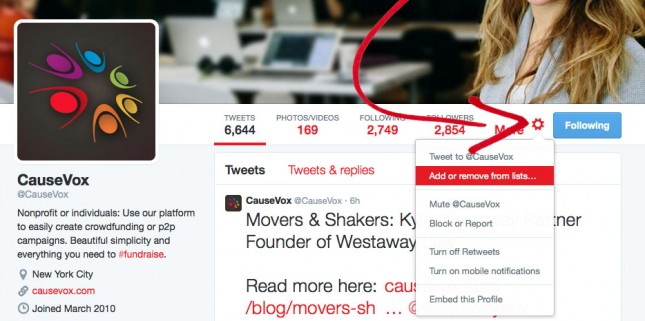
While crowdfunding gives you access to a much wider audience for spreading your message and connecting with potential supporters, it can also put you at risk of diluting your message. With access to so many people, you need to make sure that you are spending your time wisely and getting in front of the most relevant audiences: those who care about what you care about and are most likely to support you.
You’ve probably had the experience of putting your brilliant article or fundraising idea out into the social media ether, only to have it mostly ignored. Your idea may be a good one, but unless it takes root among people who care–your target audience–it will simply get swept away by the ever-moving tide that is the social internet.
Social media has a lot of tools to help you reach your target audience if you know how to use them. Here are 5 strategies you can apply to make sure your crowdfunding campaign gets in front of the right eyes.
Twitter: Go Beyond Hashtags
One of Twitter’s greatest strengths is its ability to filter out communities. Most people are familiar with hashtags, which basically function as the subject line on an email, marking a tweet as about #solarenergy or #womenleaders, for example.
What is more difficult is finding out which people are worth following and reaching them. Just because someone uses a hashtag doesn’t mean they are concerned about the topic on a regular basis. With a little digging, you can lock on to the right people to follow.
First, look out for big Twitter accounts in your field. If you are a solar energy nonprofit, you should be following solar energy news profiles, solar energy companies, and journalists who regularly write about solar energy. But you can’t stop there. Dig into the follower lists of those profiles and follow those who follow the big-name profiles. These are the people who are interested in learning more about solar energy, and they will probably be interested in following you, too.
Second, instead of searching for hashtags or keywords, search for retweets or shares of profiles similar to you. Someone who shares a lot of articles by a solar energy consulting firm probably cares a lot. Follow them, share their stuff, and engage them in conversation. Follow those they follow and dig into the follower and followee lists of those profiles.
Twitter: Keeping it Organized and Focused
Crowdfunding is all about engagement, and simply following people isn’t enough; you have to actually talk to them. This can be hard if your potential donors are mixed in with everyone else.
Lists solve this problem, and people don’t use them as much as they should.
Every time you follow someone, add them to a list. Solar-energy-news, solar-energy-entrepreneurs, solar-energy-investors, solar-energy-researchers, solar-energy-engineers; the more specific you can be, the better you can target your conversations.

As your lists grow, you’ll have more people to talk with. Now, when you get on Twitter to promote your work, instead of dealing with your regular feed, only deal with one list at a time. You’ll start to get a sense of the conversations taking place, and then you can chime in at the right time, with the right topic. When you do finally pitch your crowdfunding campaign, you can tailor your headline tweet to the specific list, use @ tags of key conversation leaders (make sure you have built a relationship first), and use the right hashtags.
Tools like Hootsuite and Tweetdeck are specifically designed to allow you to view multiple lists side-by-side, and this can help you track overlapping interests, share relevant information across lists, and share your crowdfunding campaign with the perfect hook.
Check out this article for even more in-depth Twitter tips.
LinkedIn: All About Groups
LinkedIn, when it’s not just a glorified resume, can seem like the high school lunchroom of social media: everyone has their own table, and getting invited to sit with the cool kids is all about who you know.
This is true to an extent, but, just like high school, sometimes all it takes is asking to join in.
On LinkedIn, groups are the bread-and-butter of developing a following. A lot of LinkedIn users will make posts to their general profile, but this is a scatter-shot approach. Start by researching groups in your field and join or request an invite.

Then, get a sense of how the group works. Some are very strict about sharing outside content and the moderators will kick you out for violating their rules. Others just want to make sure you’re a real contributor before they tolerate self-promotion. Others are designed for just that and real conversations don’t happen.
Make sure you know what kind of group you’re dealing with. When you’ve become a regular, you can post your promotional material or ask the moderator how you can share it.
Even if posting directly to the group is not permitted, once you start becoming active on groups, you’ll get more interest in postings to your general profile. Make sure you’re utilizing your group interactions to continue building your network so that you can send direct messages to relevant people as your articles go up.
Facebook: Living Keywords
Facebook users tend to be less comfortable making online-only connections than those on LinkedIn and Twitter, but there are still groups, pages, and public profiles you can follow and contribute to. These tend to tolerate outside postings more than LinkedIn, particularly if they are directly related to the topic of the group or page.
Facebook does allow for some very powerful focusing methods using keywords. Posts can be promoted, which amounts to advertising on a per-ad basis. If you have a large network, this can ensure that more of your friends see your posts, though whether they are interested or not is difficult to measure.
Facebook’s advertising methods are closer to social sharing and integrate very well in the regular social interactions of the site, but they allow filtering which allows you to make sure your get in front of the right people.
Spend your time on the filtering options to ensure that you are spending money wisely on Facebook.
Some tips for using Facebook to build a community.
Meetup: Bridging the Gap Between Internet and Face-to-Face
An oft-overlooked social networking tool is Meetup, which allows members to organize casual get-togethers in their local area for those interested in a particular topic. Anyone who shows up to a solar energy meetup is going to be interested in solar energy.
While Meetup is limited to local encounters, it is highly targeted and can give you access to the networks of passionate people. It’s also powerful because it allows you to make introductions and pitches in person, which is always a bonus.
Best practices for utilizing Meetup are to attend one or two events organized by others before you suggest your own or try to share promotional materials with the group. If your crowdfunding campaign is relevant and you’ve shown yourself to be a sincere member of the group, it will be received with open arms. Meetup admins also have access to their members’ email accounts, so you can get your crowdfunding campaign in their inboxes directly.
While this option does take more work, it basically amounts to highly targeted networking. Just don’t abuse the meetups you attend.
Editor's Picks
Ultimate Guide To Peer-to-Peer Fundraising
Customer Story: Spur Local Raises Over $1M With Their Give Local Campaign
Fundraising Strategies for Nonprofits: Craft the Best Approach for Your Organization
Create a Killer Fundraising Plan - Best Practices, Strategies, & Downloadable Template



